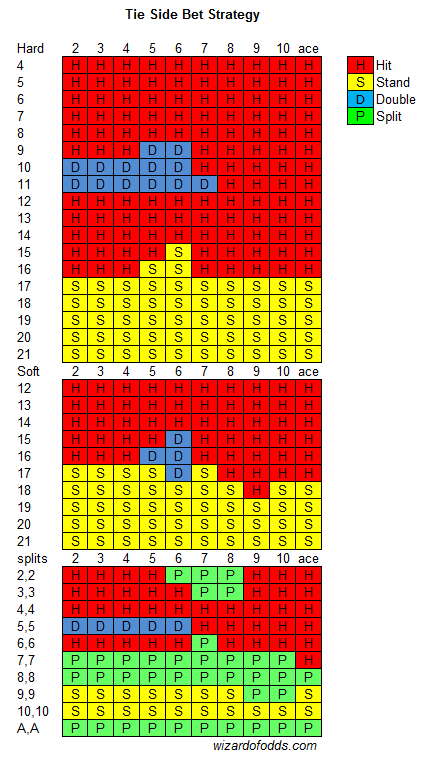On this page
Tie
Introduction
I've seen two bets calling themselves the "Tie" over the years.
The first time was at Caesars Palace. Years later I saw the thing under the name "Push Your Luck" at the Palace Station. In this version, the bet won if the player and dealer do tie and pays 10 to 1. The player may bet no more than 50% of their original blackjack wager on the side bet. If the player splits he must also split the side bet. If the player doubles, he does not double the side bet.
In the second version, seen in August 2010 at Harrah's Las Vegas. There the player could bet on all six possible ties (17, 18, 19, 20, 21, and blackjack) individually, or in groups.
All Ties Pay 10 to 1 Analysis
For the version where all ties pay 10 to 1, I assumed for the following blackjack rules:
- Winning blackjack pays 3 to 2.
- Six decks.
- Dealer hits soft 17.
- Double after split allowed.
- No surrender.
- No re-splitting aces.
The following table shows the proper basic strategy assuming the maximum side bet is played and the rules above.

Assuming the rules and strategy above, I show an overall house edge of 0.24%, which is the expected player win divided by the initial 1.5 units bet. If a winning blackjack paid 6-5, then the house edge would be 1.15%.
Individual Ties Version
The version at Harrah's, where the player can bet on specific ties, I assumed the rules they followed at the time, which were:
- Six decks
- Blackjack pays 6 to 5.
- Dealer hits soft 17
- Double after split allowed.
- No surrender.
- No re-splitting aces.
- If player doubles, he does not double the tie wagers.
- If player splits, he does not double the tie wagers. Any tie wagers will be resolved based on the first hand played out.
- An ace and 10 after splitting aces is considered 21 points for purposes of both the blackjack and tie wagers.
- If the player re-splits, then all tie wagers are lost.
The layout had betting circles for 17, 18, 19, and LS (left side) tie wagers on the left of the betting circle for the blackjack wagers. The other four tie wagers are on the right side. The player may bet up to half his blackjack wager on the sum of the four left side tie wagers, and likewise up to half on on the right side.
If the player does bet a tie, it significantly changes the strategy. The player will do more hitting, and less of everything else. There is a separate strategy for each tie wager. I won't bother to publish them unless the game gets a significant number of placements.
I spent all day trying to analyze this one, but the doubling and splitting rules made it too difficult. So I'm quoting below pay table #4 from the game owner's web site, blackjacktie.com, with permission.
Tie (version 2) House Edge
| Tie Wager | Pays | House Edge |
|---|---|---|
| 17 | 50 | 2.41% |
| 18 | 45 | 5.79% |
| 19 | 50 | 3.67% |
| 20 | 25 | 8.47% |
| 21 | 125 | 10.85% |
| BJ | 400 | 7.18% |
| LS (17, 18, 19) | 15 | 8.07% |
| RS (20, 21, BJ) | 20 | 9.39% |





